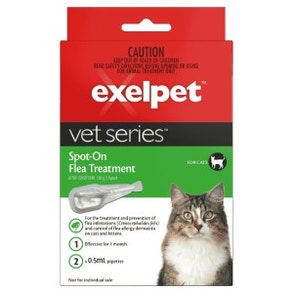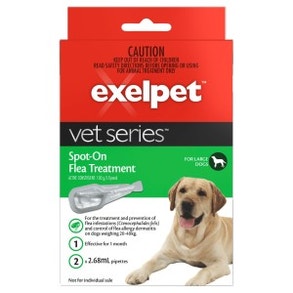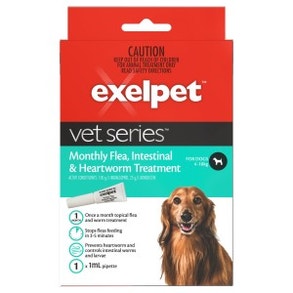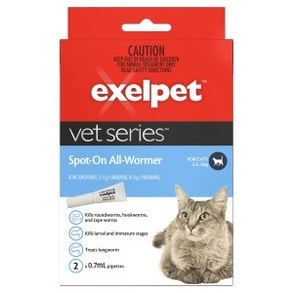Keeping your pet free of fleas is important for their health
Fleas are more than just a common nuisance to dogs and cats. Control of these blood sucking parasites is vital for your pet’s health and welfare. Flea bites are intensely irritating to the skin and can cause severe chronic dermatitis. Very heavy flea infestations can even cause anaemia in young puppies and kittens, due to the constant blood loss. Fleas also act as the intermediate host of a type of tapeworm.
Lifecycle of the flea
Includes time on pet & in the environment
It is important to understand the lifecycle of the flea, as certain types of flea control products work at different parts of the lifecycle.
Fleas need an occasional blood meal from their host, which is usually a dog or a cat. Adult female fleas and immature fleas (pupae) can survive in the environment for up to 12 months. The fleas you see on your pet represent a fraction of the total flea population in the environment. This means that the management of all the other stages of the flea including eggs, larva and pupae are critically important for a successful flea control.
Female fleas can lay up to 50 eggs per day which then fall off the pet. The developing fleas spend most of their life away from the dog or cat, preferring dark, warm environments, often in bedding or carpets where your pet rests or sleeps. The complete life cycle from egg to adult flea can take as little as one month (see diagram below). Adult fleas emerge with the onset of warm weather, heating of homes during the winter or simply changes in your pet’s environment. The hatching of the adult flea from its cocoon is also triggered by vibration, so mass hatching can occur in a house which has been unoccupied for some time.
The flea life cycle speeds up in warmer weather, so flea numbers often build up rapidly during the spring, resulting in a flea epidemic in summer. The key to flea control is to start early, before flea numbers build up. Remember to treat all your dogs and cats and their environment.

Flea bite dermatitis
In a proportion of animals, the skin becomes hypersensitive to a protein found in the flea’s saliva, so a single flea bite is enough to provoke a violent reaction in the skin. If untreated, flea allergy results in constant itching, leading to hair loss, further skin damage and secondary infections. Treatment for flea allergy dermatitis can be lengthy and expensive, so it is far better to avoid the problem in the first place by keeping your pets and their environment free of fleas.

Checking your pet for fleas
Adult fleas spend most of their life off their host, preferring dark, warm environments, so you may not see any fleas on your pet.
Look for dark specks of material (flea faeces, also known as “flea dirt”) in the coat, particularly along the back and near the base of the tail. Flea dirt can be distinguished from ordinary dirt by the fact that it turns a reddish brown colour rubbed with a damp cotton ball. The brownish-black fleas are usually difficult to see, although you may spot them moving through your pet's hair near the skin.
Flea Control program
EXELPET™ products provide a safe and effective range of solutions to target fleas at all four stages of the flea lifecycle.
Flea control products designed to repel and/or kill adult fleas are known as adulticides. Because immature fleas and flea eggs are not affected, the treatment must be repeated regularly.
The larval stages of fleas can be controlled with other chemicals known as insect growth regulators (IGRs). IGRs do not kill adult fleas, but prevent immature fleas from completing their lifecycle, and can be used in conjunction with adulticide products. They have very low toxicity and a long duration of action. If your pets are inside the house at all, vacuum carpets, skirting boards, and furniture thoroughly then use a flea bomb or spray containing IGRs to treat indoor areas.
 Maintain program year round & specifically in warmer months to reduce fleas in environment.
Maintain program year round & specifically in warmer months to reduce fleas in environment.
The key to effective flea control is starting early, before adult fleas build up and start to multiply. For effective control, use EXELPET™ flea
prevention regularly, all year round.
Explore our Flea control products
Be aware that some flea control products are designed only for use on cats or only for dogs
Remember to treat all pets in the household. Flea control products are scheduled poisons and should be handled with care. Problems arise when these chemicals are used at higher than normal concentrations, more frequently than recommended or in combination with other products.
Always read and follow the directions for use and ask your vet for advice if in doubt. Remember flea control products should be used according to label advice and handled with care. Always follow the directions for use and ask your vet for advice if in doubt.




